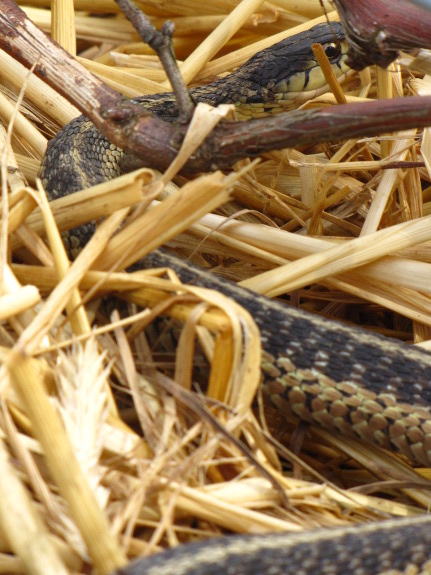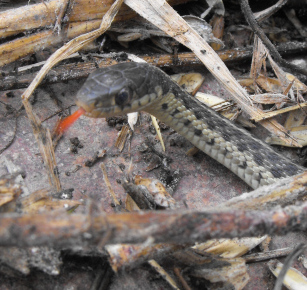
Garter snakes in the garden
 I've
been dipping back into Edible
Forest Gardens recently because when I first read the two volume
set, it was like drinking from a firehose --- a lot of the best
information went right past me. On further perusal, a throwaway
line in appendix 5 caught my interest: Garter snakes are "not as
beneficial to gardens as believed".
I've
been dipping back into Edible
Forest Gardens recently because when I first read the two volume
set, it was like drinking from a firehose --- a lot of the best
information went right past me. On further perusal, a throwaway
line in appendix 5 caught my interest: Garter snakes are "not as
beneficial to gardens as believed".
The authors didn't
provide any extra information, so I've been turning
the phrase over and over in my head ever since. Jacke and
Toensmeier did mention that earthworms make up 80% of a garter snake's
diet, so maybe the dislike is due to garter snakes eating beneficial  invertebrates?
If that's the case,
though, surely they would have said the same thing about worm snakes.
invertebrates?
If that's the case,
though, surely they would have said the same thing about worm snakes.
Since a garter snake
model kindly posed for my photo shoot Monday, I
thought I'd toss the question out at our readers. Why do you
think garter snakes are "not as beneficial to gardens as believed"?
Want more in-depth information? Browse through our books.
Or explore more posts by date or by subject.
About us: Anna Hess and Mark Hamilton spent over a decade living self-sufficiently in the mountains of Virginia before moving north to start over from scratch in the foothills of Ohio. They've experimented with permaculture, no-till gardening, trailersteading, home-based microbusinesses and much more, writing about their adventures in both blogs and books.
Want to be notified when new comments are posted on this page? Click on the RSS button after you add a comment to subscribe to the comment feed, or simply check the box beside "email replies to me" while writing your comment.

I feel the reason that you would want the gardner snake, or any snake for that matter, to stay out of your garden is........................
Short pieces of garden hose are used in a garden to replicate snakes habitating in your garden. Snakes keep several types of beneficial birds out of a garden.
If you use your chickens to help rid your garden of bugs, the snake may keep the chickens from performing their task.
If you have a dog, and I have seen many dog tare up a large space of ground to get to a snake, your garden may be partially destroyed by a dog trying to get at a snake.
Gardner sakes are food for other snakes that you may not want in your garden because they are dangerous. If the snake does not live in your garden there is no reason for the more dangerous snake to be there.
That is it for me.
Mona --- It sounds like you really don't like snakes. I can't say I agree with any of those reasons not to want snakes in the garden. In my experience, having predators higher up the ladder (like snakes) keeps the whole ecosystem in balance.
I can't say I agree with any of those reasons not to want snakes in the garden. In my experience, having predators higher up the ladder (like snakes) keeps the whole ecosystem in balance.
I think that birds (both native and chickens) are smart enough to know that a little garter snake isn't going to be able to swallow them. The hoses people use to deter birds mimic much larger snakes.
Lucy is a digger, but snakes aren't usually in the ground, so she doesn't have to dig to get to them. In fact, rat snakes eat small mammals (and other snakes to some extent), so snakes probably would cut back on dog digging in the garden.
The main snakes that eat other snakes (in our area at least) aren't harmful at all. Of our two poisonous snakes, copperheads sometimes eat snakes, but also eat small mammals, birds, lizards, amphibians, and insects. Rattlesnakes don't seem to eat other snakes at all. I somehow doubt having a few garter snakes in the garden is going to attract either.
But, as you can tell, I'm pro snake. I've only seen poisonous snakes in the wild a handful of times during a very outdoorsy life, so I don't worry much about them.
Rein --- Interesting. Do you mean the caterpillars in the ears of corn when you say corn worms? We always have a few of those, but not many. Maybe our garter snake is doing his job.
Ikwig --- That's about how I feel about most things in the garden. If they're not obviously causing problems, they're good indicators of biodiversity.
Dennis --- That'd have to be a pretty small frog or a pretty big garter snake! I'd actually like to have some of the bigger snakes around, but Lucy eats anything larger than a garter snake, and we have lots of frogs and toads.
As I see it, D Baird's comment is extremely sound. Frog's don't crawl out out of the pond big. I could so easily see even a small garter snake getting an inside tip that the tadpoles have all grown legs, and finding the perfect dark little place to snatch them up as they crawl out of the water - even before they have learned to hop! In a sustained environment, the presence of garter snakes could certainly lower the frog population. ] j [
Jeremiah --- Good point. I've been pondering the funny comments on this post and decided that we're all irrational about snakes --- either thinking they're good with no data or that they're bad with no data. (A bit like religion....)
I think you're right that a garter snake could eat young frogs and toads, but I doubt they'd put much of a dent in our population. If every tadpole within hopping distance of our garden during just one spring grew up and came to visit, they would literally cover the entire ground. I think parent toads only need one tadpole out of the hundreds they parent each year to survive, if that, to keep populations steady. Presumably, amphibian-eating snakes work a bit like wolves and mountain lions used to, culling the weaker members so the more fit ones survive to pass on their genes.